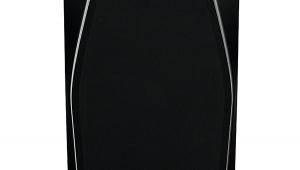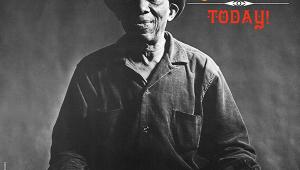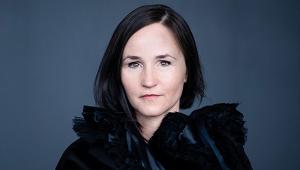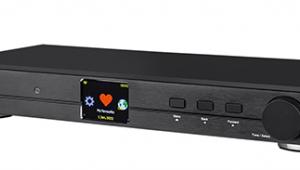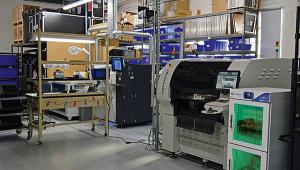Audel Art Cg Tower (£3725)
 Italy has a prized reputation for flamboyant and uniquely styled luxury goods. The nation’s passion for design is woven into the very fabric of its culture. That’s why the country’s cars look like Ferrari Enzos rather than Ford Cortinas and why the men driving them are probably wearing Gucci loafers, rather than grubby sneakers.
Italy has a prized reputation for flamboyant and uniquely styled luxury goods. The nation’s passion for design is woven into the very fabric of its culture. That’s why the country’s cars look like Ferrari Enzos rather than Ford Cortinas and why the men driving them are probably wearing Gucci loafers, rather than grubby sneakers.
For a new high-end hi-fi company to be launched and get noticed is no easy task, especially in the loudspeaker market, where, to some, looks can be as important as sound, and where rivals include exotic brands such as Sonus faber and Zingali. Audel has risen to this challenge by introducing speakers combining creative thinking and art deco looks with good old-fashioned workmanship skills.
The CG Tower reviewed here is Audel’s Reference Series flagship model, with a price tag of £3425 in standard form. Our samples included ebony inset front and rear panels costing £300 more than the standard black acrylic. Excluded were the £225 optional bespoke stands which act as outriggers for the speakers’ spiked feet and add to the Tower’s curvy-cool wood styling.
The Reference Series also offers two cube-like standmount models: the £1375 CG 509 and the £1925 CG 618 (a beefed-up version of the 509 with a larger woofer and cabinet).
HAND CRAFTED
All Reference Series models use SEAS 27mm silk dome tweeters with neodymium magnets and SEAS bass drivers with reed/paper pulp cones: ‘The secret [of the Reference Series] is the paper-like driver and the way it interacts with the cabinet,’ explains Audel’s Walter Carzan. ‘Our drivers have an excursion of 22mm and while they’re hard, they’re also extremely light which makes them very fast.’
What really makes Audel’s speakers special are the cabinets, which are made from sheets of birch plywood, computer control cut, glued and pressed together at the required depth. Audel believes this method makes each speaker cabinet behave as a single block of wood, so minimising resonances associated with individual panels in box-style speakers.
‘The construction of the cabinet is the heart of our products,’ says Walter. ‘Building cabinets in this way ensures exceptional rigidity and more importantly, all the cabinets respond identically.’
A quick glance at the speakers side-on reveals hundreds of exposed birch layers as the sides curve seamlessly into the top surface of the speaker. A gorgeous satin finish is achieved through six stages of hand-sanding, and this is followed by a coating of beeswax.
QUALITY INTERNALS
Forming the cabinets from solid blocks has also allowed the designers to tailor the thickness of each cabinet wall to maximise rigidity and damping. For the CG Tower, the front wall is 35mm thick, the sides and rear 25mm and 18mm respectively. Internal damping comprises a layer of synthetic wool, which all adds to the speaker’s overall weight of 22kg. So far so good, although all this attention to detail seems somewhat let down by the comparatively thin (6mm) ebony panel covering most of the Tower’s rear. A ‘knuckle wrap’ test on this back panel returned a far louder response than the other speaker surfaces.
The CG Tower is bass loaded via a port near the top of the rear panel. Its internal 38litre chamber is cross-braced with thick sections of birch ply, again to improve rigidity. The crossover is mounted directly behind the speaker terminals on a dedicated balsa board and employs Jantzen capacitors throughout. Audel has also used good quality 1.5mm audio grade multi-strand cable inside the cabinets, which runs in dedicated channels down the back of the front panel. These internal cables are soldered onto the crossover board and driver terminals, although (presumably for assembly purposes) the cables are split and joined midway along their runs by spade connections.
To couple the speakers to the floor, Audel supplied its heavy ‘triangulated base mount spikes’.
WELL BEHAVED
After running the speakers in and experimenting with various angles and placements, I eventually settled on a distance of 25mm between the back of the speaker and a rear wall, with the speakers toed in slightly. This position provided the most satisfying combination of soundstage depth and focused midrange without over-emphasising treble. It should however be noted that these speakers are not that placement sensitive and they sound consistent within a broad range of positions – which may be a real bonus to those with challenging listening rooms. So Audel has clearly engineered the Tower’s thick, dense cabinet walls to the keep their behaviour in check.
U2’s album Achtung Baby [Island 510 347-2] might unintentionally have been designed to aid bass tuning when positioning speakers, especially on tracks such as ‘Ultra Violet’ and ‘Love Is Blindness’.
With some, set too close to a rear wall, the room will be flooded with thunderous boom, or set too far out and the bass dissolves into a haze of unfocused reverberation. With these Audels, though, I was able to find the sweet spot within three ‘listens’ and was rewarded with a strong, confident bass of a kind that’s eluded me in the past with some other speakers. Okay, it wasn’t as bone-shaking as with a few similar sized free-space models I’ve heard, but their tolerance of closer placement to a rear wall means the CG Tower behaves more like a front- than rear-ported speaker.
It seemed only fitting to continue serious auditioning with music from Audel’s homeland via a digitally remastered CD of Tosca, with Pavarotti and Freni [Decca 414 036-2] and within a few opening bars I sensed the Towers were in their comfort zone. Their sound is blessed with a subtle delicacy that keeps each instrument nicely balanced and working in harmony. It’s like being at a concert and having the best seat in the house, where you can hear everything in equal measure rather than being too close to one particular section of the orchestra.
The sound was tight and buoyant, although during some parts of Puccini’s masterpiece I couldn’t help feel that the speakers didn’t quite deliver the full energy and gusto of the work.
PASSION AND POWER
Swapping my Black Rhodium Jive speaker cable for the thicker Van Damme Blue Series soon put paid to this, however. The passion that had seemed lacking now came through in spades with Sherill Milne’s rich baritone demonstrating that, properly integrated, the combination of paper drivers and real wood cabinets can capture the organic timbre of the human voice like few other materials. In fact, the way these speakers make vocals sound, well, human – instead of a studio enhanced replication – gets right back to hi-fi basics and so had me eagerly digging out pieces with vocals to lose myself in.
The Audels got deep under the skin of Rachel Unthank & The Winterset’s 2007 CD The Bairns [EMI 5099950438020], their textured midband providing the perfect platform for Becky Unthank’s distinctive nasal vocals on tracks such as ‘My Donald’ and ‘Sea Song’.
AC/DC’s Back In Black [ATCO 7567-92418-2] showed that the Tower’s weren’t afraid to let their hair down. The swagger of Angus Young’s lead guitar on ‘Hell’s Bells’ was let rip at full throttle and I was no longer hearing speakers – I was hearing Augus’ guitar amp cranked up to 11!
INVIGORATING
Returning to acoustic material via an LP of Janis Ian’s Between The Lines [Columbia X698] took me to the heart of what the Towers are all about. With a sound that’s so natural, so unforced, I began to suspect the glow of hidden valves in the chain, despite knowing mine was a solid-state amp supplying the juice.
So there are a few softened edges, the bass lacks a final kick-in-the-guts octave and maybe the soundstage isn’t on stadium levels, but you have to ask yourself could you live with these characteristics on a daily basis? The Towers offer a more refined proposition which will never leave you bruised after a long listening session. Instead, when it’s time to switch off you’ll likely be left invigorated and wanting more.
VERDICT
There’s an old adage that says to make a speaker sound like a real instrument, you must build it like one, and on this basis the CG Towers should sound like a Stradivarius violin. Their natural, warm and unforced sound is very easy to live with and their unusually high tolerance for room placement will make them a stylish choice of high-end floorstander for smaller or compromised listening rooms.
Originally published in the January 2012 issue
















